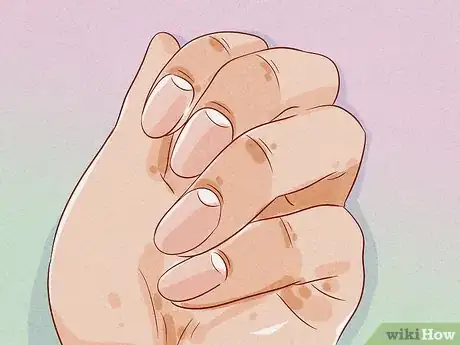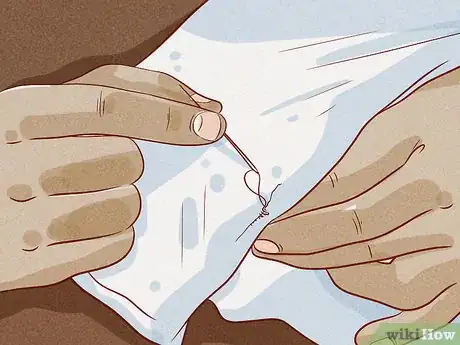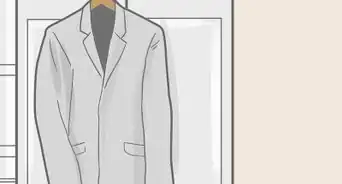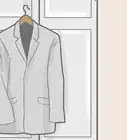This article was co-authored by Cassandra Sethi. Cassandra Sethi is a Personal Stylist, Image Consultant, and the Founder of Next Level Wardrobe, a luxury personal styling service for busy professionals. With over 20 years of fashion industry experience, Cassandra helps people transform their confidence by creating a work wardrobe they love to wear. Cassandra holds a BA in Fashion Merchandising from California State University, Long Beach, and a Postgraduate Certificate in Fashion Buying and Merchandising from the London College of Fashion. She created Soulcycle's retail business and was the Senior Buyer for 90+ Equinox gyms. Cassandra has been featured on New York’s PIX11 in an interview about how to achieve great work-from-home style as well as in Men's Health, Business of Fashion, and NYMag.
There are 11 references cited in this article, which can be found at the bottom of the page.
This article has been viewed 63,201 times.
Dressing for success means wearing clothing that makes a great impression! You might want to dress for success if you have a job interview, you are hoping to get promoted, or if you have a big workplace event coming up, such as a meeting or presentation. Figure out what the situation is and how you should dress for the occasion. Then, start building a wardrobe of professional attire by taking stock of what you already have and what items you might need to fill in the gaps. Before you head out the door, ensure that everything is in order from head to toe.
Steps
Evaluating Your Workplace Attire Requirements
-
1Find out the dress code requirements for your employer. Each employer usually has their own dress code and examples of the types of clothing that are and are not acceptable in the workplace. Familiarize yourself with these guidelines to ensure that you are always wearing workplace appropriate items. Your employer may also use special designations, such as:[1]
- Business professional, which generally means a suit with closed-toe dress shoes.
- Business ready, which includes slacks or a pencil skirt, dress shoes, and a blouse, and you should also keep a jacket on hand for business professional situations, such as a meeting with a client.
- Business casual, which is generally a blouse or sweater with a pair of slacks or a skirt and workplace appropriate shoes.
-
2Wear a suit or work dress for an interview, presentation, or big meeting. You’ll always want to put on an extra-professional outfit for certain situations, such as if you’re going for a job interview, meeting a new client, giving a presentation, or attending a big meeting. If you’re not generally required to wear a suit to work, then save your suit or work dress for these occasions.[2]
- Women's clothing stores often have wear-to-work dresses, which may be paired with a jacket or worn alone.
Tip: Wearing a suit or dress only for special occasions will send your employers and clients the message that you take the meeting or event seriously and you are determined to be successful.
Advertisement -
3Stick to more casual workplace attire for everyday situations. Dressing for success doesn’t mean you have to go all out with your clothing every day. Wear professional attire that is more toned down for everyday situations, such as a typical Monday at the office with no big meetings on the agenda.[3]
- For example, you could wear a button-down white blouse with a pair of black slacks and a pair of black dress shoes.
- Or, you could wear a nice plum-colored sweater with a grey pencil skirt, opaque black tights, and a pair of black dress shoes.
-
4Identify whether or not following trends could benefit you in your field. Usually, it’s best to avoid wearing trendy items to work and instead stick with classic items. However, some professionals may benefit from or even be expected to keep up with current fashion trends. Consider if your profession is one where you might gain an advantage from incorporating trendy items into your look.[4]
- For example, if you work as a high school teacher, then donning the occasional trendy item might be a nice conversation starter with students.
- Or, if you work in the fashion industry, then incorporating trends into your wardrobe can help to demonstrate to employers and clients that you are current in your field.
Building Your Professional Wardrobe
-
1Pair separates to create a variety of workplace appropriate looks. Having several classic separate pieces in your wardrobe will allow you to mix and match easily. Check to see what you already have and then fill in the gaps as needed. The pieces your basic professional wardrobe should include are:[5]
- 1 suit, either with a skirt or pair of pants and a jacket
- 2 pairs of dress slacks in black, dark grey, or tan[6]
- 1 black pencil skirt (if you like wearing skirts)
- 2 button-down blouses, in a white, grey, or other workplace appropriate color
- Several workplace appropriate blouses and sweaters
- A pair of black dress shoes, such as closed-toed heels or flats
- A blazer in a core color is another great addition to your professional wardrobe. It doesn't have to be completely traditional, though! Try a subtle plaid or pinstripe print, a texture like bouclé, or smaller details like buttons or zipper pockets.[7]
-
2Choose modest shirts, blouses, and sweaters. Avoid tops that are revealing, tight-fitting, or otherwise inappropriate for the workplace. Make sure that the tops you wear cover your cleavage, waist, and shoulders completely.[8]
- If you have a cute blouse that has a plunging neckline, don’t worry! You can still wear it. Just save it for a date or other special occasion instead of wearing it to work.
-
3Opt for loose fitting slacks and just above knee-length skirts. Avoid choosing slacks that are too tight, low-cut, or otherwise revealing. Stick with wide-cut and relaxed-fit trousers. Choose skirts that are no shorter than 2 in (5.1 cm) above your knee.[9]
Tip: If you’re having trouble envisioning what an appropriate workplace outfit might be, then search and browse images on Pinterest or Google. This can help to give you ideas for how to pair items in your wardrobe for a professional look.[10]
-
4Go with dark, drab, and neutral colors for most situations. Black, grey, navy, and white are classic workplace attire colors. However, you can also opt for plum, burgundy, cream, beige, brown, and dark green. Choose clothing in colors that you like, but keep color to a minimum. It’s best to avoid bright colors, neons, and pastels altogether since these look more casual than dark and neutral tones.
- You can opt for bold colors on occasion if it’s appropriate for your workplace and the situation, such as on a day when you only need to dress in business casual attire. Some colors even have psychological associations. For example, yellow reflects positivity, blue is relaxing, red indicates assertiveness, and green is the color of empathy.[11]
Putting the Finishing Touches on Your Professional Look
-
1Practice good hygiene and grooming. Always maintain excellent hygiene for the workplace and whenever you meet with a potential employer or client. Take a shower, brush your teeth, style your hair, and make sure your nails are well groomed. You can also do your makeup if you like wearing makeup, but keep it simple and understated.[12]
- If you wear nail polish, stick with clear or neutral colors. Avoid wearing bright or bold nail polish in the workplace.
- Less is more with makeup in the workplace! Opt for a tinted moisturizer or light foundation and some neutral lipstick. If you wear eye makeup, stick with a neutral, matte shade of eyeshadow and a coat of mascara.
- Get regular haircuts to keep your hair looking nice. You may wear your hair down to work as long as you keep it brushed and out of your face, or you can pull it back into a ponytail, bun, or braid.
-
2Make sure that your clothes fit you well. Avoid wearing items that are too small or large on you.[13] This will result in a sloppy look, which can reflect poorly on you in a professional setting. Employers and clients may see this as a lack of effort, which can subconsciously reduce their confidence in your abilities.[14]
- If you have lost or gained weight, look through your wardrobe to see what items you ought to retire. For example, if you have several items that are 2 sizes too big, you may want to donate or sell these and replace them with items in your current size.
- Consult a personal stylist or tailor to make sure your clothing fits you properly.[15]
-
3Iron your clothes so they are wrinkle-free. If you notice any wrinkles in your clothing, iron them before you wear them in a professional setting. Never go to work or an interview in wrinkled clothing because this sends the message that you are not detail-oriented. It can also reduce the employer’s confidence in your abilities.[16]
- Having a neat and stylish appearance will help to communicate to others that you are a professional.[17]
-
4Check your clothing for damage regularly and mend or replace damaged items. Check for stray threads, tears, and pilling on any items that you plan to wear to work. If an item is damaged, you can try to mend it or you can replace it. However, never wear a damaged piece of clothing to work as this sends the message that you don’t pay attention to details.[18]
- Don’t pitch everything in your closet just because it has a small defect! You might be able to do a simple fix on some items in your wardrobe, such as by sewing up a torn seam, cutting off stray threads, or replacing missing shirt buttons.
-
5Keep jewelry and other accessories to a minimum. Wearing a tasteful necklace or pair of earrings is appropriate for women in the workplace. However, wearing lots of jewelry can be distracting. Stick with simple jewelry and accessories, such as a pair of stud earrings or a delicate necklace.[19]
- If you like to carry a purse, get a stylish black handbag to store your items.[20]
Tip: A good rule of thumb is that if you could go straight from work to a nightclub, then you are not dressed appropriately for work.[21]
Community Q&A
-
QuestionWhat should I wear to look professional?
 Cassandra SethiCassandra Sethi is a Personal Stylist, Image Consultant, and the Founder of Next Level Wardrobe, a luxury personal styling service for busy professionals. With over 20 years of fashion industry experience, Cassandra helps people transform their confidence by creating a work wardrobe they love to wear. Cassandra holds a BA in Fashion Merchandising from California State University, Long Beach, and a Postgraduate Certificate in Fashion Buying and Merchandising from the London College of Fashion. She created Soulcycle's retail business and was the Senior Buyer for 90+ Equinox gyms. Cassandra has been featured on New York’s PIX11 in an interview about how to achieve great work-from-home style as well as in Men's Health, Business of Fashion, and NYMag.
Cassandra SethiCassandra Sethi is a Personal Stylist, Image Consultant, and the Founder of Next Level Wardrobe, a luxury personal styling service for busy professionals. With over 20 years of fashion industry experience, Cassandra helps people transform their confidence by creating a work wardrobe they love to wear. Cassandra holds a BA in Fashion Merchandising from California State University, Long Beach, and a Postgraduate Certificate in Fashion Buying and Merchandising from the London College of Fashion. She created Soulcycle's retail business and was the Senior Buyer for 90+ Equinox gyms. Cassandra has been featured on New York’s PIX11 in an interview about how to achieve great work-from-home style as well as in Men's Health, Business of Fashion, and NYMag.
Personal Stylist & Image Consultant Focus on core colors that won't go out of style and are endlessly versatile. You can also incorporate structure into your wardrobe with a power blazer or dress pant.
Focus on core colors that won't go out of style and are endlessly versatile. You can also incorporate structure into your wardrobe with a power blazer or dress pant. -
QuestionIs it okay to dress kind of feminine at work?
 Nejla ReneeNejla Renee is a fashion stylist, image consultant, and personal shopper based in New York, New York. With over seven years of experience, Nejla specializes in helping people enhance their positive attributes and express their identities through style. Nejla holds a BS in Marketing and Finance from Northeastern University and worked in finance prior to starting her own business. Nejla combines her business experience with her personal creativity, passion, keen eye for detail, innate sense of style, and strong understanding of fit and proportion to help her clients create peace and acceptance around their style.
Nejla ReneeNejla Renee is a fashion stylist, image consultant, and personal shopper based in New York, New York. With over seven years of experience, Nejla specializes in helping people enhance their positive attributes and express their identities through style. Nejla holds a BS in Marketing and Finance from Northeastern University and worked in finance prior to starting her own business. Nejla combines her business experience with her personal creativity, passion, keen eye for detail, innate sense of style, and strong understanding of fit and proportion to help her clients create peace and acceptance around their style.
Fashion Stylist & Image Consultant Absolutely! So long as you aren't violating any dress code rules at work, there's absolutely nothing wrong with embracing your femininity.
Absolutely! So long as you aren't violating any dress code rules at work, there's absolutely nothing wrong with embracing your femininity. -
QuestionHow do I approach the subject of an employee who wears clingy clothing without underwear?
 Community AnswerFirst, understand it's a fashion statement. What you are talking about is all over Instagram. Start off by saying that you accept she is making a statement, but you would rather she wear something under her clothes. Try to sound less like you are talking down to her, and more as if you are giving her fashion a re-direction.
Community AnswerFirst, understand it's a fashion statement. What you are talking about is all over Instagram. Start off by saying that you accept she is making a statement, but you would rather she wear something under her clothes. Try to sound less like you are talking down to her, and more as if you are giving her fashion a re-direction.
References
- ↑ https://www.sbu.edu/docs/default-source/life-at-sbu-documents/professional-wardrobe-nbsp-.pdf?sfvrsn=0
- ↑ https://www.realsimple.com/beauty-fashion/clothing/dress-for-success-0?slide=86376#86376
- ↑ https://www.realsimple.com/beauty-fashion/clothing/dress-for-success-0?slide=86376#86376
- ↑ https://www.realsimple.com/beauty-fashion/clothing/dress-for-success-0?slide=91371#91371
- ↑ https://www.sbu.edu/docs/default-source/life-at-sbu-documents/professional-wardrobe-nbsp-.pdf?sfvrsn=0
- ↑ Cassandra Sethi. Personal Stylist & Image Consultant. Expert Interview. 15 February 2022.
- ↑ Cassandra Sethi. Personal Stylist & Image Consultant. Expert Interview. 15 February 2022.
- ↑ https://www.forbes.com/sites/carolkinseygoman/2018/10/18/how-savvy-business-women-dress-for-success/#489745882d8c
- ↑ https://www.forbes.com/sites/carolkinseygoman/2018/10/18/how-savvy-business-women-dress-for-success/#489745882d8c
- ↑ https://www.forbes.com/sites/carolkinseygoman/2018/10/18/how-savvy-business-women-dress-for-success/#489745882d8c
- ↑ https://www.realsimple.com/beauty-fashion/clothing/dress-for-success-0?slide=107997#107997
- ↑ https://www.forbes.com/sites/carolkinseygoman/2018/10/18/how-savvy-business-women-dress-for-success/#489745882d8c
- ↑ Nejla Renee. Fashion Stylist & Image Consultant. Expert Interview. 7 August 2020.
- ↑ https://www.forbes.com/sites/carolkinseygoman/2018/10/18/how-savvy-business-women-dress-for-success/#489745882d8c
- ↑ Cassandra Sethi. Personal Stylist & Image Consultant. Expert Interview. 15 February 2022.
- ↑ https://www.forbes.com/sites/carolkinseygoman/2018/10/18/how-savvy-business-women-dress-for-success/#489745882d8c
- ↑ https://www.realsimple.com/beauty-fashion/clothing/dress-for-success-0
- ↑ https://www.forbes.com/sites/carolkinseygoman/2018/10/18/how-savvy-business-women-dress-for-success/#489745882d8c
- ↑ https://www.forbes.com/sites/carolkinseygoman/2018/10/18/how-savvy-business-women-dress-for-success/#489745882d8c
- ↑ https://www.sbu.edu/docs/default-source/life-at-sbu-documents/professional-wardrobe-nbsp-.pdf?sfvrsn=0
- ↑ https://www.realsimple.com/beauty-fashion/clothing/dress-for-success-0?slide=68547#68547
- ↑ https://www.forbes.com/sites/carolkinseygoman/2018/10/18/how-savvy-business-women-dress-for-success/#489745882d8c


















-Step-20.webp)
-Step-16.webp)
-Step-9-Version-3.webp)









-Step-20.webp)



































